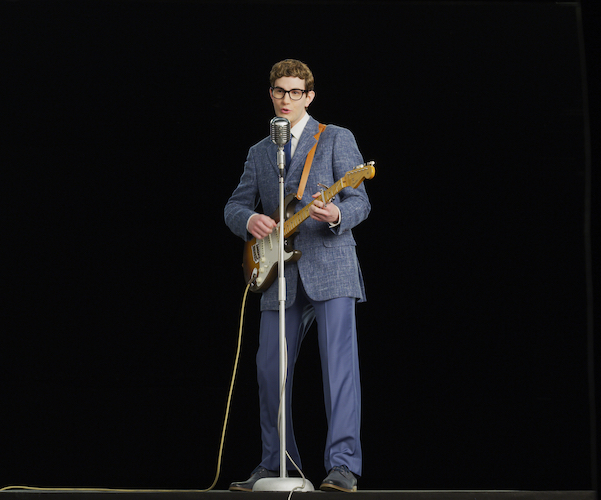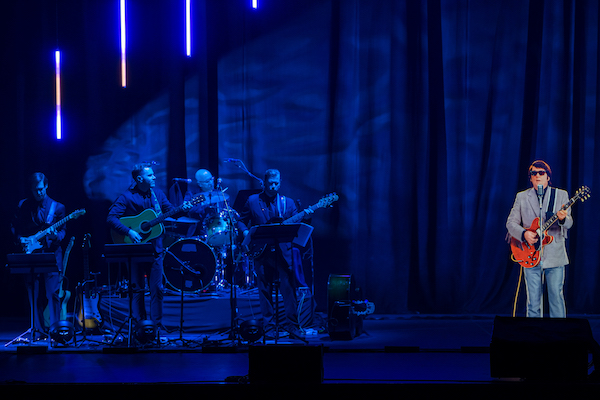Music Preview: “Roy Orbison & Buddy Holly: The Rock ’n’ Roll Dream Tour” — Virtual Presence
By Scott McLennan
Believe it or not, Buddy Holly is on tour with another deceased rock ’n’ roll pioneer — Roy Orbison.

Buddy Holly hologram on tour. Photo: Base Hologram
It’s unclear which is more mind scrambling: the number of incredible songs Buddy Holly produced over a short two-year span before his tragic death at age 22 in 1959, or that Buddy Holly is on tour in 2019.
Never mind that Holly is on tour with another rock ’n’ roll pioneer — Roy Orbison, who died in 1988.
Hologram technology is making concerts starring performers from “the great beyond” possible and increasingly popular. The technology has improved — and become more mobile — since a hologram of the late rapper Tupac Shakur “performed” at the Coachella festival in 2012. This year alone, there have been lengthy tours built around holograms of heavy metal icon Ronnie James Dio, freak-out maestro Frank Zappa, and opera star Maria Callas. And there has already been a lot of chatter generated by a planned Whitney Houston hologram tour for 2020.
The Roy Orbison & Buddy Holly: The Rock ’n’ Roll Dream Tour will be at the Boch Center Shubert Theatre for an 8 p.m. show this Saturday (November 16).
Aesthetic questions abound when it comes to these “concerts” by manipulated images of popular musicians no longer with us. The fact is, in most cases, audiences are not seeing an image of the artist; instead, they being are served up pictures of a look-alike actor — digitally edited and altered to come as close as possible to resembling the star in question. It’s a version of the computer graphics technology used to insert the likenesses of Carrie Fischer and Peter Cushing into Star Wars movies filmed after those actors had died.
While not three-dimensional, hologram images manage to generate a lifelike quality to their movements. And what audiences get out of a hologram performance — that they won’t get from a tribute band, musical, or film — are an artist’s original vocals.
In the case of the Holly and Orbison show, the recordings of their best-known songs are synced to images projected on stage and accompanied by live musicians and backup singers. This particular production also features snippets of Holly and Orbison performance footage interspersed into the show.
From a business perspective, hologram tours are manna, a fresh way to tap into the nostalgia market.
And that is why the Holly estate got involved in the hologram game.
“Of all the early rock ‘n’ roll pioneers, Buddy is probably the least well known,” said David Hirshland, who bought the rights to Holly’s music and likeness from the artist’s widow, Maria Elena Holly, in 2015. “He passed away at such a young age that there was so much lost, and that includes memories of him and a general consciousness of his work.”
That’s not to diminish the impact of Holly’s work. The Beatles (named in part in tribute to Holly’s band the Crickets) and the Rolling Stones championed Holly with their respective covers of “Words of Love” and “Not Fade Away” early in their careers. Linda Ronstadt turned three Holly songs — “That’ll Be the Day, “ “It’s So Easy” and “It Doesn’t Matter Anymore” — into hits in the mid-’70s. Eric Clapton and Steve Winwood’s supergroup Blind Faith recorded an epic version of Holly’s “Well All Right” on its sole studio album. The Raveonettes, Elvis Costello, Blondie, Cat Power, Mickey Gilley, John Doe, and several others across the years and genres of pop and rock have tackled Holly’s tunes.

Roy Orbison hologram “performing” with live musicians. Photo: Base Hologram.
And then there was The Buddy Holly Story, a 1978 film that won an Academy Award for its score and earned Gary Busey an Oscar nomination for his portrayal of Holly.
But as Hirshland pointed out, “That was 40 years ago.” He added that “anything that we can do to get the music out there is valuable.”
Orbison enjoyed a career renaissance prior to his death. Bob Dylan, George Harrison, Jeff Lynne, and Tom Petty made Orbison part of their successful Traveling Wilburys group, and Orbison’s early rock ‘n’ roll hits from the ’60s found their way into popular contemporary films of the ’80s, Blue Velvet among them. This made Orbison a concert draw right up to his death from a heart attack in 1988.
In contrast, very few people ever got to see Holly perform.
Base Hologram had already developed and toured an Orbison show by the time the Holly estate became interested in doing a Holly-gram show. Base and the estates for both artists saw an opportunity to expand on the Orbison show and create a tribute to the two Texans who helped lay rock ‘n’ roll’s foundation.
Hirshland acknowledges that there is still a fair amount of skepticism regarding hologram “concerts,” but he is banking that the technology will catch on as a popular form of entertainment.
“People have to suspend disbelief, but that’s typical for lots entertainment,” he said. “Unlike watching a movie, this does more to create a concert experience. At the end of the day, it’s fun and it’s a tribute to two amazing artists we have lost.”
Scott McLennan covered music for the Worcester Telegram & Gazette from 1993 to 2008. He then contributed music reviews and features to The Boston Globe, The Providence Journal, The Portland Press Herald and WGBH, as well as to the Arts Fuse. He also operated the NE Metal blog to provide in-depth coverage of the region’s heavy metal scene.

Hi,
Saw Roy version in NYC, and it had a static creepiness that wasn’t enjoyable to me.
Hoping the technology with prevail and it gets more personal.